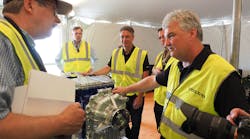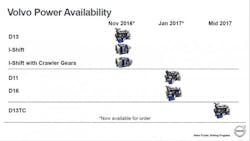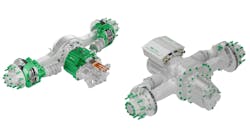OEM: Class 8 orders low, inventories growing, but '17 tech shows promise
SHIPPENSBURG, PA. Noting, as many have, that retail sales for Class 8 trucks in North America have lagged this year, Volvo Trucks North America (VTNA) execs say truck dealers' inventories are swelling and present a problem for the market picking back up. At the same time, the latest 2017 fuel-efficiency technologies that've come about thanks to federal Greenhouse Gas Phase I regulations are rolling out and opening new possibilities.
"There's pretty slow order-taking in the industry overall," contends Magnus Koeck, vice president for marketing and brand management at VTNA. "Everyone is facing the same challenge." Manufacturers have continued churning out trucks at fairly high rates — as has Volvo, he notes — "and when the market slows down, it just builds up in terms of inventory out at dealerships." Still, the company continues to project North American Class 8 sales this year of 250,000 units.
VTNA also sees some bright spots in the trucking industry spectrum, and the OEM just began this week demonstrating its latest advancements in engines and transmissions both with the first wave of customers and Tuesday morning with a group of reporters. The company specified when new 2017 tech unveiled earlier this year goes into production and did some show-and-tell with the hardware and how it works (watch for our breakout look next week).
One standout has been VTNA's Wave Piston technology going into D11 and D13 heavy-duty diesel engines. The company essentially has built a better mouse trap in this case, redesigning the piston crown itself with six "tabs" or divots that better concentrate and shape the fuel mixture to promote combustion. In testing, the OEM was showing the new pistons reduce soot output by a very significant 90%, so VTNA got new testing equipment to check it again and make sure.
"We thought our testing equipment might be faulty. It wasn't the equipment," says Wade Long, director of product marketing at VTNA. "What is soot? It's unburnt fuel," he points out, explaining that the Wave Piston improves flame propagation for improved fuel economy and greatly reduced soot. The technology going into Mack and Volvo engines could mean changes may be possible regarding the need for treatment like diesel particulate matter filtering.
Volvo's I-Shift transmissions are another star of the show for 2017, particularly with new "Crawler" add-on gears designed as a lower-cost alternative to provide extreme slow-speed control valuable in vocational and heavy haul-type applications while allowing a rear-axle ratio that gives fuel efficiency at highway speeds. Vocational trucks "can drive down the highway at a decent rpm when they're cruising and they come back home instead of running at 1,700 rpm or so trying to do 65 mph," says John Moore, a product marketing manager at VTNA.
"Lots of people say, 'It's a dump truck, I don't care.' Well, if you have 50 of them and you're talking a 3% gain in fuel efficiency, that adds up fast," Moore tells Fleet Owner. "We're excited even to be able to be talking about fuel efficiency with vocational vehicles. It also aids in engine longevity and reliability as well; it's less stress when you're running an engine at 1,500 rpm instead of 1,800 rpm, less vibration."
With the flexibility it allows, VTNA's Koeck contends that the I-Shift transmissions "definitely can do all the work that the customer needs."
VTNA has six more predictions and observations for the heavy truck market:
1. The prices of diesel/ crude oil will remain on the low side. "We anticipate overall that diesel prices on average will remain low at about $2.27/gal. and [the price of crude oil] about $50/barrel; I think it was around $47 yesterday (Monday)," Koeck notes.
2. Manufacturing will stay about even. The North American manufacturing market will remain about flat for this year, VTNA predicts, part of the reason orders are flagging.
3. Long haul will decline as regional/ short haul gains. VTNA, like others, is tracking trends toward more regional- and short-haul — and likely also for day cabs and corresponding equipment — and away from long-haul. "Four, five, six years ahead, we see that long haul will come down a little bit, actually. It has been at roughly half [of the U.S. market] or a bit more, 53% or so, and that will continue to go down to about 43%," predicts Koeck.
"Some of that is regionalization of distribution networks, and some is drivers wanting more home time; the driver shortage impacts it as well," he adds.
As to what effect the now-expanded Panama Canal will have on North American freight transportation, however, "it's still early to be seen," notes Koeck, and some are skeptical. Should more — and/or larger — ships come to U.S. Eastern Seaboard ports rather than West Coast ones, "that will impact transportation distances, and ultimately product offerings," he adds.
4. Construction will gain. The construction industry is a bright spot VTNA sees for trucking, and is targeting higher vocational sales as a result. "Construction spending will grow," Koeck says. "That we see now and in the coming years."
5. Bargain diesel likely means marginal near-term outlook for Compressed Natural Gas (CNG) and other alt fuels. "Eventually, diesel prices and oil prices will come up and [alternative fuels] will grow, but today CNG is about 2% overall in the U.S. [heavy trucking] market. We monitor that as well as anyone else, but we think that will remain flat for now," says Koeck.
6. Proprietary power and transmission installations also are gaining. Particularly now that OEMs have had to address their heavy duty engines' fuel efficiency as part of the last wave of GHG regulations, heavy trucks may see more vertical integration. VTNA has, according to Koeck. In 2008, the first year its I-Shift transmissions were built in North America, Volvo installed them in about 15% of new trucks. As of May 2016, the company says I-Shifts are now going into 88.8% of new trucks. Volvo engines, meanwhile, went into about 53% of new trucks in 2008, and Volvo power now goes into 94.5%.





